Moving Tips & FAQ’S
What type of boxes should I use for household goods?
Use new packing materials. Although the boxes you might obtain from your neighborhood supermarket may be free, they are not nearly as durable or padded as new boxes. They are more susceptible to causing damage to your valuables in transit. Many packing material suppliers will deliver within few days anything you may need. You can place your order online, or contact your local packing materials supplier.
What items not to ship?
It is recommended that you do not ship the following articles:
- Valuable and important papers such as family records, birth certificates, marriage documents, financial information and other like documents.
- Jewelry
- Fire Arms (license is required in some countries)
- Live Plants or Seeds (license is required in some states)
- Open bottles containing any liquids or other contents
- Flammable cleaning solutions or other toxic liquid substances
- Alcohol (in hand luggage only)
- Pressure spray can
Check with customs regulations, or call the consulate for other possible restrictions in your destination country.
What are the steps in loading a container?
The boxes you will need first should be loaded last. This might include toys, cleaning supplies, light bulbs, blankets, pillows, and sheets. Read the inventory form carefully, and ask the team leader to explain anything you don´t understand. Make a note of your shipment´s registration number, and keep your Bill of Lading handy.
It is your responsibility to see that all of your goods are loaded, so remain on the premises until loading is completed. To ensure that nothing gets left behind, always do a final inspection of the premises. Do not sign any releases without completing this inspection.
What is shipping by consolidation?
Consolidation is for LCL (less than container load) shipments. This term is commonly used in the sea freight industry and by international moving companies to describe a sea freight service that’s designed for shipping boxed, crated or palletized cargo that cannot fill an entire 20 or 40-foot sea container.
There are three ways for your possessions to be loaded into the steel container:
- Loose: Your goods will be loaded into the container just as they have been picked up from your home. Each box must be numbered and labeled with your name, destination address, and phone number. It is recommended that this information is in English and the language of your destination country.
- Palletized: Your goods will be put on to a pallet or pallets and shrink wrapped. These pallets will then be loaded into the steel container. This option is suitable if your shipment consists mostly of boxes.
- Lift Van: The lift van is a standard size wooden crate, or it may be custom made to suit your shipment. We recommend the lift van as the safest and most secure way to ship your personal belongings.
What cannot be shipped as LCL?
You CANNOT use LCL Service for the following commodities:
- Unboxed or uncrated cargo cannot be shipped as LCL.
- Any motorized vehicles that require DMV registration (cars, motorcycles, mopeds, jet skis, ATV’s, snowmobiles, etc) are not permitted to be moved as LCL sea freight. This is due to US Customs Regulations that will not recognize any warehouse as an exam site for inspection.
What is an exclusive container?
Exclusive container or FCL (full container load): If you choose this option, it means that your belongings and only your belongings are in the container. The two most commonly used standard size containers are 20 feet and 40 feet long.
How can I transport my automobile?
Vehicles can be shipped in two different ways: RO/RO (roll on/roll off) or in an exclusive container. With RO/RO, your vehicle is driven on to the vessel, protected from the elements, secured for transport, and driven off at the port of destination. With an exclusive container, your car is loaded into the container, prepared and secured for transport. The container is locked and delivered to the port of destination. You may also ship some household goods in the container with the vehicle.
Can I pack my belongings in my car?
As of 1998, the U.S. Dept. of Transportation ruled that you may NOT load any items in a vehicle on auto carriers. All trucks are subject to occasional inspection which includes unloading the cars and the items in the car. This could risk leaving the things behind. Auto carriers are NOT licensed to carry household goods or personal items and are not covered by carrier’s insurance. Any damage to your vehicle due to household goods shifting or breaking is also not included. Personal belongings left in the car are shipped strictly at the owner’s risk. Carriers will not inventory any belongings left in the vehicle and will assume no responsibility. Also, items packed in the vehicle add weight and may cause damage to the exhaust system and or suspension of the vehicle.
How far in advance should I plan for international shipping?
The summer months are the peak months of the moving season. For a move planned from May to October, allow at least four weeks prior notice for all bookings. For a move planned from November to April, allow at least two weeks prior notice for all bookings. In case of an emergency, though, we will make every effort to arrange a move within five days.
How are shipping costs calculated?
Moving costs are based on total volume (measured in ft² cubic feet) or weight of your personal belongings. A typical move consists of three main parts: Origin, Ocean and Destination. The basis for calculating Origin costs in the US is the weight of your shipment. Usually rates are given in the trade per 100 pounds of weight.
Customs
What do I need to know about U.S. customs?
We will assist you to get the final approval on your cargo. We issue the required export forms. All you will have to do is supply all commercial invoices and sign export instructions.
How do you deal with foreign customs?
Many foreign governments will request duties for your cargo shipment and may have laws that will impact your shipment, whether it consists of cargo or household goods. You should be prepared to provide receipts for any new merchandise in your shipment. To help you with the nuances of dealing with a foreign government, we will be glad to assign an agent to you. Of course, you can always select your own.
Who is responsible for incidental charges assessed by foreign governments?
While we do our best to inform you of all the potential charges that you may be faced with, destination charges and importation through the destination port are ultimately the responsibility of the receiver.
Do I need to be present when my container is delivered?
Be sure to be present when the delivery crew arrives. Plan to stay around while they unload in case they have any questions. If you cannot be there personally, be sure to authorize an adult to be your representative to accept delivery. Inform the destination agent of your chosen representative´s name. Your representative will be asked to note any change in the condition of your goods noted on the inventory at the time of loading.
Insurance
Should I purchase insurance?
It is strongly recommended that you purchase an insurance policy that covers the shipping of your household goods, vehicles, and cargo. There are two types of systems: “All Risk” and “Total Loss.”
All Risk Marine Insurance is available to customers that have their goods professionally packed. This thoroughly covers any loss or damage to your entire shipment.
Total Loss Marine Insurance is available to customers who choose to self-pack their goods. Insurance companies will not issue All Risk insurance for household goods that are packed by the owner. The entire shipment must be a loss to make an insurance claim.
Where do I purchase a policy?
IVL will provide you with all the coverage options you’ll need. We offer two types of marine insurance to meet your needs and your budget.
Can I track my shipment?
Yes, you can. You can track your shipment in real time through our state-of-the-art technology. Just click on the Track Shipment link and follow the instructions to enter your shipment information and we will let you know where your shipment is at that time.
Can I make a payment online?
Yes, you can. Just hit the “PAY ONLINE” button at the top of any page of our website and make your payment by Visa, Mastercard, Discover, or check. It’s that easy.
You can find the required shipping forms here.








